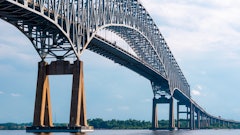
The unfortunate incident of the Dali ship, that collided into the Francis Scott Key Bridge, caused much disruption to the Port of Baltimore and its economy. The bridge, which used to carry 30,000 vehicles a day, is key in linking cargo to the port. With the collapse of the bridge and closure of the port, over 2,000 port workers have been impacted, and it could cost the Baltimore economy as much as $15 million a day.
Limited Impact on Cargo Processing Capacity Given Alternative Ports
Despite the closure of both the port and bridge, the cargo processing rate remains steady. Since there is still available capacity in the east coast ports, where cargo handling volumes continue to increase given the growing investments in the past decade.
The Port of New York and New Jersey, which handled around two million containers in the last quarter of 2023, now serves as the main alternative port for the diverted cargo. In comparison, the Port of Baltimore only handled 265,000 containers in the same period and is one of the smallest ports on the Northeastern seaboard. Other ports like the Norfolk Port in Virginia, can also accommodate more containers; it processed 850,000 containers in the same period.
Therefore, cargo loads from Baltimore can be easily redistributed to neighboring ports without much disruption.
Road Congestion in Baltimore and the Potential Rise in Trucking Cost
Following the bridge collapse, road congestion in Baltimore has become an issue. Traffic is now redirected to the Baltimore Harbor Tunnel, originally constructed to alleviate congestion in the area. Some cargo owners may now choose to transport their goods via land instead of sea now, which further contributes to the existing traffic jams. With limited capacity on the roads, the number of trucks that can travel at each point-in-time is also limited, leading to delivery delays and disrupted commutes for Baltimoreans.
According to the University of Maryland, truck travel times doubled and tripled, in some cases, due to detours around the beltway or through the tunnels. While this has not translated to higher trucking prices yet, businesses may soon see prices jack up in the next couple of months.
Likewise, some cargo owners may also look to transport via rail instead of sea, but it is unlikely that significant shifts will happen, because current capacity at the east coast ports remains sufficient.
Overall Shipping Costs May Increase for Affected Cargo Owners
Given that there is no major congestion at the ports taking the diverted ships, it is highly unlikely that the U.S. East Coast and Transatlantic freight rates will be impacted greatly.
Although ocean freight rates are unlikely to be directly impacted, transportation expenses may escalate due to longer travel distances for rerouted shipments, assuming the Port of Baltimore is the nearest port to the shipper’s point of origin or destination, along with heightened trucking costs. Consequently, this may lead to overall increased shipping expenses for affected cargo owners. In addition to cost implications, cargo owners may also expect to encounter delays. However, this may not significantly impact a warrant for cargo owners to opt to ship via other countries in a bid to mitigate rising costs and shipment time.
It is too early to tell if companies will pass on their increased transportation costs to consumers. Amidst rising U.S. consumer prices, this disruption adds to concerns about inflation, reducing the likelihood of a Federal Reserve rate cut before June.
Anticipated Q2’24 Reopening of Baltimore Port, but Years to go for Francis Scott Key Bridge
With the government’s aggressive efforts to fully reopen the port, the U.S. Army Corps of Engineers (USACE) and Maryland governor, Wes Moore, are confident of an end-May 2024 timeline. With a Q2 reopening, it’s hopeful that some commercial activity will resume, along with the upcoming opening of an alternative channel for small container ships to move automobiles and farm equipment to and from the port. Yet, road congestion in Baltimore will continue for years, which may deter cargo owners from picking the port as their port of call.
Reconstruction of the Francis Scott Key Bridge is anticipated to span several years, contingent upon bureaucratic processes and the securing of federal funds. It will take time for traffic patterns to normalize and for cargo volumes to return to their usual levels at the Port of Baltimore. However, even after the bridge is completed, a complete restoration may not be seen, as cargo diversion to other ports may solidify the positions of those ports.
Major Impact for the Maryland Economy, but Not for the U.S. as a Whole
The Dali ship collision brings about serious repercussions for the Maryland economy, especially since the bridge will take years to be rebuilt and Baltimore is its largest state. Even with the soon-reopening of the port, the damaged bridge would still stand in the way of getting cargo to and from the port easily, hampering deliveries so cargo owners may divert shipments. With decreased loads docking at the Port of Baltimore, local port workers and surrounding businesses will have reduced work which translates to lower pay. With heavy jams and delays, Baltimoreans experience reduced supply chain efficiency, hindering work productivity.
Fortunately, the ramifications are likely confined to just Baltimore. Neighboring ports, with available capacity, allow economic activity to go on as usual and bring greater revenue to those areas such as New York and Virginia. Moreover, the cargo loads processed in Baltimore are only a fraction of that processed in the other ports. Essentially, economic activity in Baltimore shifts over to other cities like New York, but still remains within the U.S.
What Can Businesses and Governments Take Away From This?
The Baltimore City Department of Transportation (DOT) is collaborating closely with the Port of Baltimore, Baltimore County and Tradepoint Atlantic, the terminal operator, to manage the influx of additional 'roll-on/roll-off' cargo at Sparrows Point. This terminal represents the sole accessible and operational area of the Port of Baltimore following the bridge collapse.
To bolster operations during this period, DOT is modifying a $8.26-million grant to aid Tradepoint Atlantic in accommodating permanent additional capacity, slated to operate by April 2024. This 10-acre expansion, doubling the terminal’s capacity from 10,000 to over 20,000 autos per month, will aid in servicing vessels unable to access other terminals at the port.
This incident underscores the importance of building a resilient supply chain. Crafting contingency plans with alternative transportation routes allows businesses to avoid reliance on just one port. In addition to this, investments in artificial intelligence (AI)-powered technology can empower supply chain players to have greater visibility of their shipments, port statuses and associated risks, enabling them to make more informed decisions on which route(s) to take for time and cost savings and how best to adjust operations accordingly. For the government, investing in infrastructure resilience like emergency response systems can minimize the duration and severity of disruptions. Above all, it is imperative for supply chain stakeholders to remain agile in responding to changing circumstances to ensure continuity during such unexpected events.

























